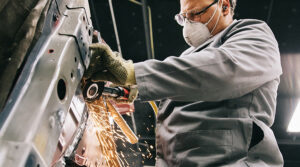
Toyota challenges updates on vital collision restore strategies
By
on
Collision Repair service
Toyota has issued a Collision Mend Information Bulletin (CRIB) reinforcing its position on some key collision repair subjects, including the prohibition against the use of warmth to straighten system and body parts, and proper welding techniques. The bulletin applies to all Toyota, Lexus, and Scion autos.
Toyota’s updates serve as a reminder that repairers really should verify for the authorized OEM method for every occupation, each and every time, no matter of producer. The bulletin ought to not be viewed as all-inclusive or a substitute for coaching, Toyota cautions.
Because high strength sheet metal is made use of for structural overall body and body factors, it is critical that warmth not be utilized in fix methods, Toyota explained. Warmth can modify the crystalline composition of the metal, creating a significant lessen in toughness, Toyota warned. Warmth also damages the panel’s zinc coating, decreasing its resistance to corrosion.
Damaged door intrusion beams have to be changed, and not fixed, Toyota claimed. Beams are developed to soak up, channel and dissipate strength in the party of a collision, and will no more time conduct as intended if fixed. Total doorway replacement is identified as for when a beam is broken, Toyota reported.
For similar explanations, weakened bumper reinforcements ought to be replaced, and not fixed, Toyota explained.
Usually speaking, physique and frame deformations that are not able to be returned to primary form by cold straightening – pushing, pulling, and hammering – are labeled as kinks, in accordance to Toyota. Elements that are kinked ought to be changed. Any deformation that can be dealt with by chilly straightening is classified as a bend.
Welded frame parts are to be put in working with fuel inert arc welding/steel inert gasoline (MIG) procedures, Toyota stated. It specifies the use of ER70S3 welding wire and encourages repairers to be certain suitable weld setting and penetration with exercise welds. Repairers ought to not weld around factory weld beads, and should thoroughly clean afflicted repair surfaces and implement epoxy primer and matching topcoat, Toyota mentioned.
The only permitted welding technique is a butt joint with out backing, Toyota reported. It warned that working with sleeves and inserts will interfere with crash electricity management styles. Repairers are directed to make certain right root-hole, weld configurations, and penetration with practice welds, and to cut and join only in destinations specified by the OEM.
Before accomplishing any electrical welding, technicians have to change off the vehicle’s ignition and take away the unfavorable link to its 12-volt battery, Toyota said. Any ECUs within just 18 inches of the weld site need to be taken out, and the main supplemental restraint procedure (SRS) pc connector must be unplugged. Toyota advises repairers to wait around at least 90 seconds after these steps to get started welding.
For far more data, take a look at the Toyota Complex Information and facts Technique (TIS).
More information and facts
I-Automobile: How to Come across Toyota/Lexus CRIBs
https://rts.i-automobile.com/collision-repair-news/how-to-locate-toyota-lexus-cribs.html
Images
Showcased graphic provided by Toyota.
Share This:
Associated







